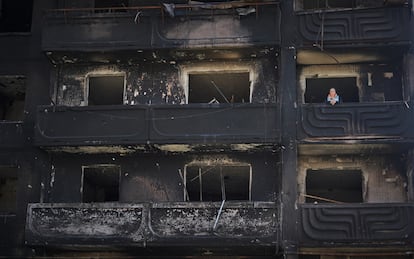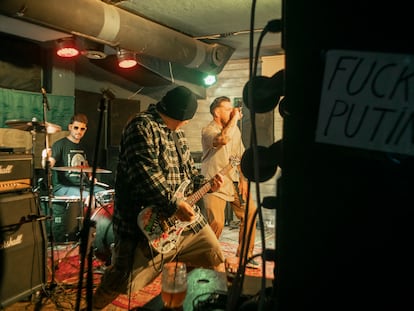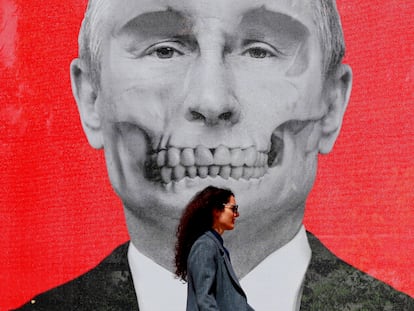The new battle in Kyiv’s suburbs: Rebuilding a life shattered by Russia
Now that a return of the enemy has been ruled out, the outskirts of the Ukrainian capital are focusing on reconstruction, reopening businesses and restoring utilities

“Mom, where are you? You’re beautiful…! How will I survive without you?” Between sobs, Natalia Mirko, 52, hugs her mother’s coffin. Professor Anna Starostenko, 73, was one of the few residents who stayed in her house in Irpin during the month of occupation of this Ukrainian city by the Russians. The woman survived the fighting and the lack of water, electricity and gas. But on May 9, just over a month after the invaders had withdrawn and when the city was beginning to come back to life, her heart gave out. Life in Irpin continues its course. So does death. The grave of this doctor in economics is surrounded by dozens of others, all covered in flowers. They are some of the approximately 300 civilians who died under the yoke of the Russian occupation in this town on the outskirts of Kyiv.
The specter of a possible return of Kremlin troops, which haunted residents in the first days after Ukrainian authorities regained control, seems to have vanished. Russian President Vladimir Putin is now more concerned with gaining ground in eastern and southern Ukraine. But getting back to normal in the suburbs of Kyiv is not going to be easy or fast. Of the approximately 100,000 people who lived in Irpin when the invasion began on February 24, only about 5,000 stayed behind. So far, some 20,000 have returned, according to data offered in her office by Julia Ustych, deputy to the mayor and in charge of humanitarian affairs at the municipal level. In other words, 75% of the inhabitants still have not returned home. Ustych, whose 17-year-old son is being fostered by a family in Spain, carries in her hand a list of the neighbors for whom they are trying to find temporary accommodation, either in Irpin itself or in a nearby town.
Another of the main battlefronts is to restore essential services. On the stairs that give access to the Town Hall, several people are taking turns next to a power strip with several plugs. “Gas has recently arrived at my house, but many things depend on electricity, such as the radio, the washing machine, the telephone…” laments Svetlana, 46, as she unwinds her mobile phone charger. Next to her is Aleksander, 59, waiting for his laptop’s battery to charge. “In my house there is still no water, no heating, no electricity,” he says.

Equipped with orange vests, a group of young people is busy clearing up a half-ruined building. They are volunteers of the District One Foundation, born in 2018 in Kyiv to fight against gentrification. With the outbreak of the conflict, they began to help looking for funds to support the army and get people food and medicine. Now their focus is on reconstruction. In coordination with the authorities – and once the explosives teams have cleaned up a site – they get to work. Paul, 36, is one of the more than 400 who make up the WhatsApp group where they are organized. Covered in dust, he is outraged at what he saw while cleaning up a school in Borodyanka that the Russians had occupied. “Inside the library, they were crapping on the floor and wiping their asses with our flag.”
In recent days some businesses have been reopening in Irpin, especially grocery stores, where there are even fresh products such as meat or fruit. But the streets remain almost deserted and there are very few children on the street with their parents. School Number Two remains closed and with significant damage caused by the projectiles.
The columns of smoke had barely disappeared when Cristina, 25, and Andrei, 26, a couple from Irpin, resumed their cafeteria project in the neighboring town of Bucha. They had been given the keys to their new business on February 23. But on the morning of the 24th, the Russian invasion brought everything to a halt. Now they are waiting for the last windows to be installed so they can open the doors of Ristretto. The café is located on Station Street, now renamed Tank Avenue after a Russian armored column was shelled at this point on its way to take Kyiv.
The silence is only broken by some passing vehicles, and desolation continues to impose its law on Irpin. The open wounds in houses and buildings are still visible to all. Many are unrecoverable. The damage is especially serious in the area that separates this town from Bucha. On the main avenue, Maxim, 44, and other workers from the Best Internet company are working to replace the damaged wiring with a new one. “Today the internet is used for everything,” he says while a yellow public bus adds a note of color against the black of the fire that has charred the facades of the buildings.

One of these charred buildings contains the home of Natalia, 45, who returned last Tuesday from western Ukraine, where she took refuge. She escaped when the clashes had just started, leaving only broken windows in her third-floor apartment. Upon her return, she saw how the flames had devoured everything. In the midst of the desolation, a red saucepan still sat on one of the stoves. The sound of crunching glass under her feet was the only thing to be heard in a deserted and uninhabitable building.
Natalia, who now spends hours on the street killing time, was one of the thousands of inhabitants who fled across the bridge that connects Irpin with the capital. The bridge was blown up by the local army to stop the Russian advance and it ended up becoming a symbol of the war. The Kremlin’s troops never made it beyond that strategic location, just five kilometers from the entrance to Kyiv. But blowing up the bridge made it difficult to evacuate Irpin and other besieged towns. Up to 40,000 residents fled the fighting, according to estimates by the municipal authorities, going over planks placed there as a precarious footbridge over the river. Those images made global news. The bridge has not yet been rebuilt, but there is already a brand new parallel road that has reestablished communication between Irpin, Bucha and other cities with Kyiv.
“The attackers finally managed to enter our city and 70% of the infrastructure was destroyed or affected. Schools, kindergartens, residences, buildings, cultural centers”, lists Julia Ustych. But at the same time, the municipal employee proudly recalls that Irpin was the last bastion protecting Kyiv. “Irpin became a fortress to protect the capital from the Russian occupiers,” she says. Now, the shiny blacktop that runs alongside the ruins of the bridge symbolizes the desire to win the battle of reconstruction.
Tu suscripción se está usando en otro dispositivo
¿Quieres añadir otro usuario a tu suscripción?
Si continúas leyendo en este dispositivo, no se podrá leer en el otro.
FlechaTu suscripción se está usando en otro dispositivo y solo puedes acceder a EL PAÍS desde un dispositivo a la vez.
Si quieres compartir tu cuenta, cambia tu suscripción a la modalidad Premium, así podrás añadir otro usuario. Cada uno accederá con su propia cuenta de email, lo que os permitirá personalizar vuestra experiencia en EL PAÍS.
¿Tienes una suscripción de empresa? Accede aquí para contratar más cuentas.
En el caso de no saber quién está usando tu cuenta, te recomendamos cambiar tu contraseña aquí.
Si decides continuar compartiendo tu cuenta, este mensaje se mostrará en tu dispositivo y en el de la otra persona que está usando tu cuenta de forma indefinida, afectando a tu experiencia de lectura. Puedes consultar aquí los términos y condiciones de la suscripción digital.
More information
Últimas noticias
Most viewed
- Sinaloa Cartel war is taking its toll on Los Chapitos
- Oona Chaplin: ‘I told James Cameron that I was living in a treehouse and starting a permaculture project with a friend’
- Reinhard Genzel, Nobel laureate in physics: ‘One-minute videos will never give you the truth’
- Why the price of coffee has skyrocketed: from Brazilian plantations to specialty coffee houses
- Silver prices are going crazy: This is what’s fueling the rally











































